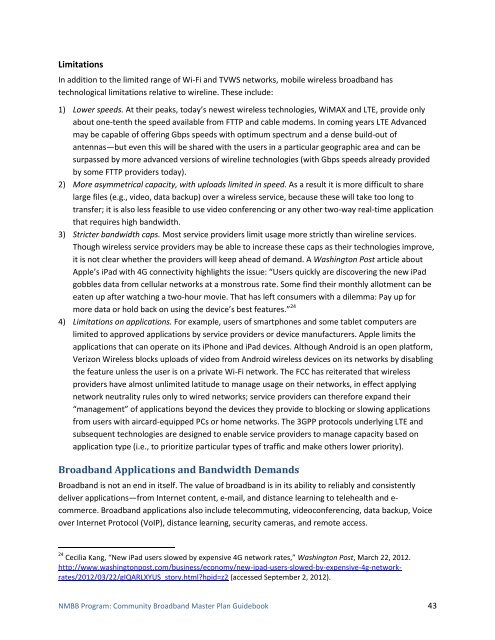Community Broadband Master Plan Guidebook
Community Broadband Master Plan Guidebook - CTC Technology ...
Community Broadband Master Plan Guidebook - CTC Technology ...
- No tags were found...
You also want an ePaper? Increase the reach of your titles
YUMPU automatically turns print PDFs into web optimized ePapers that Google loves.
LimitationsIn addition to the limited range of Wi-Fi and TVWS networks, mobile wireless broadband hastechnological limitations relative to wireline. These include:1) Lower speeds. At their peaks, today’s newest wireless technologies, WiMAX and LTE, provide onlyabout one-tenth the speed available from FTTP and cable modems. In coming years LTE Advancedmay be capable of offering Gbps speeds with optimum spectrum and a dense build-out ofantennas—but even this will be shared with the users in a particular geographic area and can besurpassed by more advanced versions of wireline technologies (with Gbps speeds already providedby some FTTP providers today).2) More asymmetrical capacity, with uploads limited in speed. As a result it is more difficult to sharelarge files (e.g., video, data backup) over a wireless service, because these will take too long totransfer; it is also less feasible to use video conferencing or any other two-way real-time applicationthat requires high bandwidth.3) Stricter bandwidth caps. Most service providers limit usage more strictly than wireline services.Though wireless service providers may be able to increase these caps as their technologies improve,it is not clear whether the providers will keep ahead of demand. A Washington Post article aboutApple’s iPad with 4G connectivity highlights the issue: “Users quickly are discovering the new iPadgobbles data from cellular networks at a monstrous rate. Some find their monthly allotment can beeaten up after watching a two-hour movie. That has left consumers with a dilemma: Pay up formore data or hold back on using the device’s best features.” 244) Limitations on applications. For example, users of smartphones and some tablet computers arelimited to approved applications by service providers or device manufacturers. Apple limits theapplications that can operate on its iPhone and iPad devices. Although Android is an open platform,Verizon Wireless blocks uploads of video from Android wireless devices on its networks by disablingthe feature unless the user is on a private Wi-Fi network. The FCC has reiterated that wirelessproviders have almost unlimited latitude to manage usage on their networks, in effect applyingnetwork neutrality rules only to wired networks; service providers can therefore expand their“management” of applications beyond the devices they provide to blocking or slowing applicationsfrom users with aircard-equipped PCs or home networks. The 3GPP protocols underlying LTE andsubsequent technologies are designed to enable service providers to manage capacity based onapplication type (i.e., to prioritize particular types of traffic and make others lower priority).<strong>Broadband</strong> Applications and Bandwidth Demands<strong>Broadband</strong> is not an end in itself. The value of broadband is in its ability to reliably and consistentlydeliver applications—from Internet content, e-mail, and distance learning to telehealth and e-commerce. <strong>Broadband</strong> applications also include telecommuting, videoconferencing, data backup, Voiceover Internet Protocol (VoIP), distance learning, security cameras, and remote access.24 Cecilia Kang, “New iPad users slowed by expensive 4G network rates,” Washington Post, March 22, 2012.http://www.washingtonpost.com/business/economy/new-ipad-users-slowed-by-expensive-4g-networkrates/2012/03/22/gIQARLXYUS_story.html?hpid=z2(accessed September 2, 2012).NMBB Program: <strong>Community</strong> <strong>Broadband</strong> <strong>Master</strong> <strong>Plan</strong> <strong>Guidebook</strong> 43


